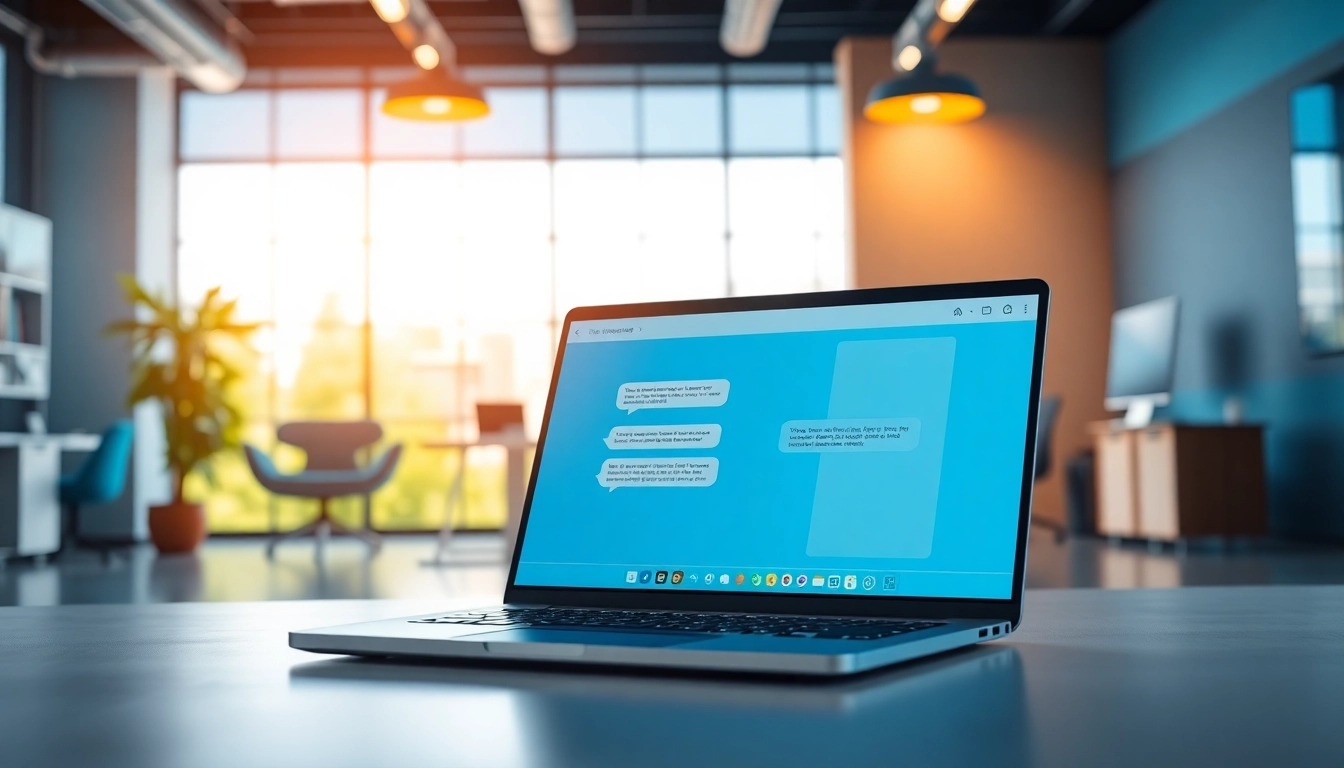Understanding the chatgpt Bot for Website Integration
What is a chatgpt Bot?
A chatgpt bot is a sophisticated conversational agent powered by the advanced natural language processing capabilities of the GPT (Generative Pre-trained Transformer) model created by OpenAI. This bot is designed to mimic human conversation in a way that feels seamless and intuitive. It can handle a wide range of queries and tasks, enhancing user interactions on websites. From providing customer support to facilitating transactions, a chatgpt bot serves as an effective digital companion that learns over time to better meet user needs. By leveraging machine learning and AI technology, the chatgpt bot can provide personalized interactions, addressing specific inquiries and assisting users in real-time.
Benefits of Implementing a chatgpt Bot
- 24/7 Availability: Unlike human agents, a chatgpt bot can operate around the clock, ensuring that user queries are addressed any time of the day.
- Instant Responses: Users no longer have to wait in line for support. The chatgpt bot can provide immediate answers, dramatically improving the customer experience.
- Cost-Effectiveness: Implementing a chatgpt bot reduces the need for large support teams, leading to savings on labor costs while still delivering quality customer service.
- Scalability: Whether you are a small business or a large corporation, a chatgpt bot can handle numerous interactions simultaneously, making it easy to scale support without adding staff.
- Data Collection and Analysis: chatgpt bots can gather valuable data about customer preferences and behaviors, allowing businesses to make more informed decisions and optimize their offerings.
Common Use Cases for chatgpt Bots
chatgpt bots can be integral in a variety of scenarios, including:
- Customer Support: Automating responses to FAQs, troubleshooting common issues, and providing real-time guidance.
- Sales Assistance: Helping users navigate products, making recommendations based on user inputs, and facilitating purchases.
- Lead Generation: Engaging potential customers through personalized conversations, capturing leads, and qualifying them for follow-up by human agents.
- Content Recommendations: Suggesting articles, products, or services based on user preferences and history.
- Booking and Reservations: Assisting users in making appointments or reservations, thereby streamlining administrative processes.
Setting Up Your chatgpt Bot: A Step-by-Step Guide
Choosing the Right Platform for Integration
Integrating a chatgpt bot into your website requires careful selection of the right platform. Many businesses prefer using platforms like chatgpt bot for website integration due to their user-friendly interfaces and robust features. When choosing a platform, consider the following:
- Compatibility: Ensure the platform can be easily integrated with your existing website or CMS.
- Customization Options: Look for platforms that allow you to tailor the bot’s appearance and functionality to suit your brand.
- Analytics Tools: Choose a platform that provides comprehensive insights into user interactions and bot performance.
- Support and Resources: Assess whether the platform offers adequate customer support and resources for troubleshooting and enhancements.
Configuring Your chatgpt Bot Settings
Once you’ve selected a platform, the next step is configuring your bot. This process includes defining the bot’s purpose, setting up its conversational flow, and integrating it with back-end systems for data retrieval. Effective configuration enables the chatgpt bot to:
- Understand and respond accurately to user inputs.
- Access relevant information databases to provide informed answers.
- Utilize natural language processing to interpret user queries accurately.
Regularly updating the bot’s knowledge base with new information about products, services, and company policies is also critical to maintain its effectiveness.
Testing Your chatgpt Bot Functionality
Before launching your chatgpt bot, extensive testing is paramount. Engage in rigorous scenario simulating actual user interactions to identify any glitches in responses or navigation. When testing, focus on:
- Response times and accuracy of answers.
- User satisfaction through simulated conversations.
- Identifying dead ends and ensuring seamless flow of conversation.
Incorporating feedback from testing into the bot design will enhance its performance and ensure a better experience for end-users once it goes live.
Enhancing User Experience with Your chatgpt Bot
Personalization Strategies for Better Engagement
To maximize the impact of your chatgpt bot, focusing on personalization is essential. Personalization involves tailoring interactions based on user data and preferences, which can significantly enhance user engagement. Key strategies include:
- Using past interactions to inform future dialogues. The bot should remember returning users and engage them with tailored conversations.
- Adjusting the bot’s responses to match the tone and language style of individual users to create a more personal feel.
- Providing recommendations based on user behavior, such as previous purchases or inquiries.
Common Challenges in User Interaction
While chatgpt bots are immensely powerful, they are not without challenges. Common issues include:
- Misinterpretation of Queries: Bots can sometimes misunderstand user inputs, leading to irrelevant responses. Regular updates and training data adjustments can mitigate this.
- Limited Context Understanding: Dry exchanges often occur when a bot fails to maintain context throughout a conversation. It is essential to configure the bot for memory retention across multiple interactions.
- User Frustration: If users encounter bottlenecks or unsatisfactory responses, they may become frustrated and disengage. A fallback to human agents for unresolved issues can help retain customer satisfaction.
Utilizing Feedback for Improvement
Feedback is integral to improving your chatgpt bot’s functionality. Regularly solicit user feedback through surveys and direct queries post-interaction, allowing you to capture and analyze insights into user experience. Implement the feedback constructively to:
- Modify the bot’s conversation templates for clarity and accuracy.
- Update the bot’s knowledge base continually based on new insights from user interactions.
- Enhance features that resonate well with users and remove those that do not meet their expectations.
Measuring the Success of Your chatgpt Bot
Key Performance Indicators to Track
To ascertain whether your chatgpt bot is achieving its intended objectives, tracking Key Performance Indicators (KPIs) is crucial. Here are some essential KPIs to consider:
- User Engagement Rate: Monitoring how often users engage with the bot can provide insights into its relevance and usability.
- Resolution Rate: This metric tracks the percentage of user queries resolved solely by the bot without human intervention.
- Response Time: Analyzing the average time the bot takes to respond to users can help gauge efficiency.
- User Satisfaction Score: Collecting user satisfaction ratings post-interaction can highlight areas for improvement.
Analyzing User Interactions
User interaction data is a gold mine for understanding how your chatgpt bot is performing. Analyzing this data effectively can help identify patterns in user behavior, leading to enhanced functionality and user experience. Key areas to focus on include:
- The most common user queries, which can inform updates to the bot’s knowledge base.
- Drop-off points in conversations, where users lose interest or abandon talks; addressing these can enhance the user experience.
- Identifying successful conversational flows that lead to resolutions or user satisfaction.
Adjusting Your Strategy Based on Data
Your chatgpt bot’s success relies heavily on data-driven decision-making. Use insights gained from interaction analyses to adapt your strategies accordingly. This may involve:
- Updating the bot’s language model or conversational flows based on user preferences and behaviors.
- Revisiting the integration of AI features such as predictive typing or enhanced NLP capabilities.
- Pacing updates and modifications based on regular reviewing of analytics to avoid overwhelming the user with changes.
Future Trends in chatgpt Bots for Websites
Emerging Technologies Impacting chatgpt Bots
As technology evolves, so too will the capabilities of chatgpt bots. Innovations such as advanced machine learning algorithms, multi-modal interactions combining text and voice, and improved contextual understanding will all play significant roles in enhancing the functionality of chatbots. Looking towards the horizon, businesses can expect:
- Integration with augmented reality (AR) and virtual reality (VR) for immersive user experiences.
- Increased use of voice recognition technology to enable seamless conversational interfaces.
- Enhanced predictive capabilities that allow bots to anticipate user needs based on historical usage data.
Predictions for User Behavior and Interaction
Understanding future trends in user behavior can arm organizations with the insights needed to refine their chatgpt bot strategies. Predictions indicate that:
- Users will expect more human-like interactions, requiring chatbots to evolve continuously in their conversational capabilities.
- Users will favor brands that provide personalized experiences and prompt support over those that do not.
- The demand for multi-platform integration—where chatbots interact across various channels (otherwise known as omnichannel experience)—will increase.
Preparing Your Website for AI Advancements
To harness the full potential of emerging chatgpt bot technologies, websites must be prepared for AI advancements by:
- Investing in robust backend systems that can support advanced AI functionalities.
- Ensuring that their websites are adaptable and scalable, keeping the latest technology trends in mind.
- Engaging in continuous learning and training to empower team members with the skills to manage and update AI tools effectively.



